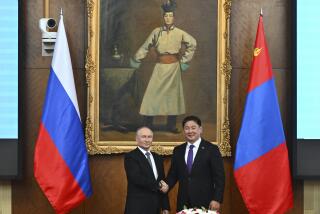A Significant Gesture From Moscow : Pullback in Mongolia Signals Sino-Soviet Cooperation
- Share via
The reduction of Soviet armed forces in Mongolia, as promised in President Mikhail S. Gorbachev’s speech to the United Nations, is not big news in the Western media. But it has great importance for Asia and the world as an indicator of the changed context and aims of Moscow’s Asian policy --especially in relations with China.
The announcement did not specify numbers, saying only that “a major portion of Soviet troops temporarily stationed there will return home.” Presumably this means a larger figure than the 10,000 (out of a total of about 75,000) announced in 1987.
A decade ago Mongolian leaders accused the Chinese of incursions into their territory, and charged that Beijing intended to annex their country. They called for retention of Soviet troops in Mongolia as a defense against China--noting for good measure that the Chinese abused the Mongols, Tibetans and other ethnic minorities under their rule. But during this decade, and especially during the past three years, Mongolian and Soviet relations with China have expanded and greatly improved. Only the restoration of inter-party relations is needed to complete a broad process of reconciliation.
The central factor in the Soviets’ willingness to reduce military forces in Mongolia is the reduction of the danger of military conflict with China--a concern that motivated the huge buildup of Soviet forces along the mutual border and in Mongolia during the 1960s and ‘70s. Mongolia, more than twice the size of Texas and possessing a population of only 2 million,could either be a controlled protective buffer for much of Soviet Asia or a possible base for hostile action. The latter was feared both during the period of Sino-Japanese war and during the long dispute with China. The Chinese had similar concerns, knowing how the Soviet military buildup in Mongolia added to the pressure on themselves--hence their inclusion of Soviet forces along the Sino-Soviet border and in Mongolia as one of the “three obstacles” to the normalization of political relations with the Soviet Union.
For their part, the leaders in Ulan Bator continue to feel concern about their future relationship with China. They have seen the ethnic Mongolian population of Inner Mongolia overwhelmed by Chinese immigration, and they know that both the Nationalist and the Communist leaders of China have sought at various times to annex the Mongolian People’s Republic.
Soviet hegemony may not be perfect, but for a nation of 2 million lying between the 270 million Soviets and a billion Chinese, it is clear that the Soviets are the preferred choice: They do not threaten the existence of the nation by demographic ingestion, and they have been notably generous with development aid. But there are also benefits for the Mongols in an improved Sino-Soviet relationship, provided their national interests can be protected.
In the current rapidly changing situation, Mongolia has sought increased security not only through maintenance of close ties with the Soviet Union (there is no more devoted fan of perestroika than Jambyn Batmonh, Mongolia’s party leader) and other Asian and European communist states and parties. But it has also expanded relations with China, including (during the past two years) a new consular treaty, an agreement on handling border problems, and agreements on cultural exchanges, scientific and technological cooperation and a railway protocol. Even the recent establishment of diplomatic relations with the United States has its role in improving security by giving Mongolia broader international ties and stressing its independence. The policy, obviously undertaken with Soviet consent and support, serves to change the image of Mongolia as a Soviet republic in all but name, and it fits well the Soviet “new thinking” in foreign policy that aims to find security by political rather than military means.
Clearly the Soviet Union and China find it far more advantageous to cooperate than to compete in their relations with the vast and strategically vital area of inner Asia that lies between them. Chinese broadcasts of a few years ago appealing for a rising of Moscow’s “colonial” subjects in Central Asia have given way to the opening of borders, cooperation in railroad construction and many other positive signs.
That a similar process is occurring in Mongolia is consistent with the broader policy. Hence the promise of a “major reduction” of Soviet troops in Mongolia is not only a plus for the future of Sino-Soviet relations; it is another important sign of how far the process has advanced.
More to Read
Sign up for Essential California
The most important California stories and recommendations in your inbox every morning.
You may occasionally receive promotional content from the Los Angeles Times.













